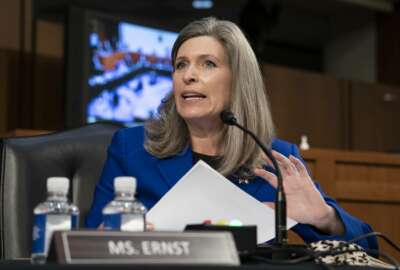Sponsored by Carahsoft
Inside SSA’s plan to become the ‘most accessible agency’ in government
Betsy Beaumon, SSA’s chief transformation officer, says the is reinventing service delivery to keep up with a growing volume of customers.
The Social Security Administration provides services to 70 million Americans each year — more than one in every five people in the United States.
SSA is serving more customers than ever before. But it also has its lowest staffing levels in more than 50 years.
Betsy Beaumon, SSA’s chief transformation officer, said the agency needs to reinvent the way it delivers services to retirees and Americans with disabilities, in order to keep up with demand.
“We have to not only go more digital, but also really look at the processes that happen internally,” Beaumon said. “We maybe had a tendency in the past to think, ‘Technology can solve X problem.’ But it doesn’t solve it unless you put all the other pieces together. We live with a lot of old technology, especially for our field folks, and we have to fix that.
SSA launched its Office of Transformation about a year ago, to better understand the challenges frontline employees face when it comes to providing services to the public.
“We are serving folks from literally birth to death and beyond, and we’re serving people at times in really high-stress, challenging parts of their lives,” Beaumon said. “That means that we have to be incredibly focused on our customer experience, because we need to serve them both with quality and with empathy.”
SSA is making its services easier to navigate online, but Beaumon said the goal is to ensure all customers can interact with the agency the way that works best for them — whether that’s in person, over the phone, or through its website.
“We need to make it as easy as possible and make sure that our front door of SSA, across the board, whether you’re coming in via phone, whether you’re walking into an office, and certainly increasingly, using other digital channels, are all very simple and consistent,” she said.
As a provider of retirement and disability benefits, Beamon said SSA ensures accessibility is at the heart of all its customer experience work.
“We are serving folks that absolutely require accessible experiences. And I believe, given our customer base, that we should be the most accessible agency in the federal government, and we’re already quite good,” Beaumon said.
CX means ‘simplicity for everyone’
SSA develops its CX work around multiple personas of people with disabilities in mind.
For example, Beaumon said SSA is focused on making sure agency notices are written in plain language, so that the recipients, including individuals with intellectual disabilities, aren’t overwhelmed with legalese.
“Our notices are hard for lawyers to understand. Imagine your grandmother receiving that. Imagine somebody with an intellectual disability receiving that. And it’s kind of a nonstarter, if some of the lawyers can’t even figure out what that all means,” she said.
SSA went through a major refresh of its website about a year ago, re-envisioning the site as a digital “front door” for individuals seeking the agency’s services. Beaumon said the website refresh incorporated feedback from its users.
“That’s a great example of how you incorporate user-centered design, constant feedback, so that you’re you can improve not only the user interface— what is their actual experience, as they go through — and thinking about equity and accessibility from the very beginning,” Beaumon said. “It’s critical that we keep going toward simplicity for everyone.”
Beaumon said SSA’s digitization effort may also benefit customers experiencing homelessness, who may not have a fixed address where the agency can send notices in the mail.
“That is a usability it’s a customer experience issue, but it is very much also an accessibility and an equity issue,” she added.
E-signatures and better phone service
Meanwhile, SSA is rolling out digital signatures for more than 30 of its forms and removing the signature requirement altogether for another 13 forms. Beaumon said the e-signatures will help SSA manage 30 million letters and packages it receives in the mail every year.
“Our offices found they were just inundated with mail that they really had had trouble processing at that time, because you didn’t have people in the office to get it,” she said.
The push to digitize its paper-based work got attention at the height of the COVID-19 pandemic, when frontline managers came into closed offices to open and process mail.
“I think that that shows you the grit of our staff and how much they care about the mission. But I think it also became very clear we need some better ways to do this. Plus, we have customers themselves saying, ‘Can’t I just do this online?’ Not everybody, but for those who want to do that, we need to be able to meet that moment,” Beaumon said.
SSA is also taking steps to improve its level of service over the phone. In addition to lower hold times, Beamon said the agency is also focused on improving its “first call resolution” — making sure customers don’t need to repeatedly call the agency to seek help.
“Whether it’s a call or a visit, how can we handle basic questions through technology that don’t really need a human to answer. How can we meet folks where they are. If they are digitally oriented, great, let’s make it so that we can serve them digitally, so that the people who do need a person to help can get to that person,” Beaumon said.
To improve those metrics, SSA is taking a closer look at why customers are calling the agency.
SSA, in partnership with the U.S. Digital Service, recently transcribed calls coming into its 1-800 phone line using artificial intelligence, to take a closer look at the reasons people called.
“A whole bunch of people call because they just don’t understand the thing we sent them,” Beaumon said. “That’s obviously driving a ton more work to our field employees, just because people have more questions, and then, frankly, they have to decipher them sometimes.”
Discover more about how to elevate your customer experience in the “Excellent, equitable and secure customer experience: A closer look at high-impact service providers” series.
Copyright © 2024 Federal News Network. All rights reserved. This website is not intended for users located within the European Economic Area.
Jory Heckman is a reporter at Federal News Network covering U.S. Postal Service, IRS, big data and technology issues.
Follow @jheckmanWFED






